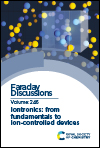Logic gating of low-abundance molecules using polyelectrolyte-based diodes†
Abstract
Bioinspired artificial ionic components are extensively utilized to mimic biological systems, as the vast majority of biological signaling is mediated by ions and molecules. Particular attention is given to nanoscale fluidic components where the ion transport can be regulated by the induced ion permselectivity. As a step from fundamentals toward ion-controlled devices, this study presents the use of ionic diodes made of oppositely charged polyelectrolytes, as a gate for low-abundance molecules. The use of ionic diodes that exhibited nonlinear current–voltage responses enabled realization of a basic Boolean operation of an ionic OR logic gate. Aside from the electrical response, the asymmetric ion transport through the diode was shown to affect the transport of low-abundance molecules across the diode, only allowing crossing when the diode was forward-biased. Integration of multiple diodes enabled implementation of an OR logic operation on both the voltage and the molecule transport, while obtaining electrical and optical output readouts that were associated with low and high logic levels. Similarly to electronics, implementation of logic gates opens up new functionalities of on-chip ionic computation via integrated circuits consisting of multiple basic logic gates.

- This article is part of the themed collection: Iontronics: from fundamentals to ion-controlled devices


 Please wait while we load your content...
Please wait while we load your content...